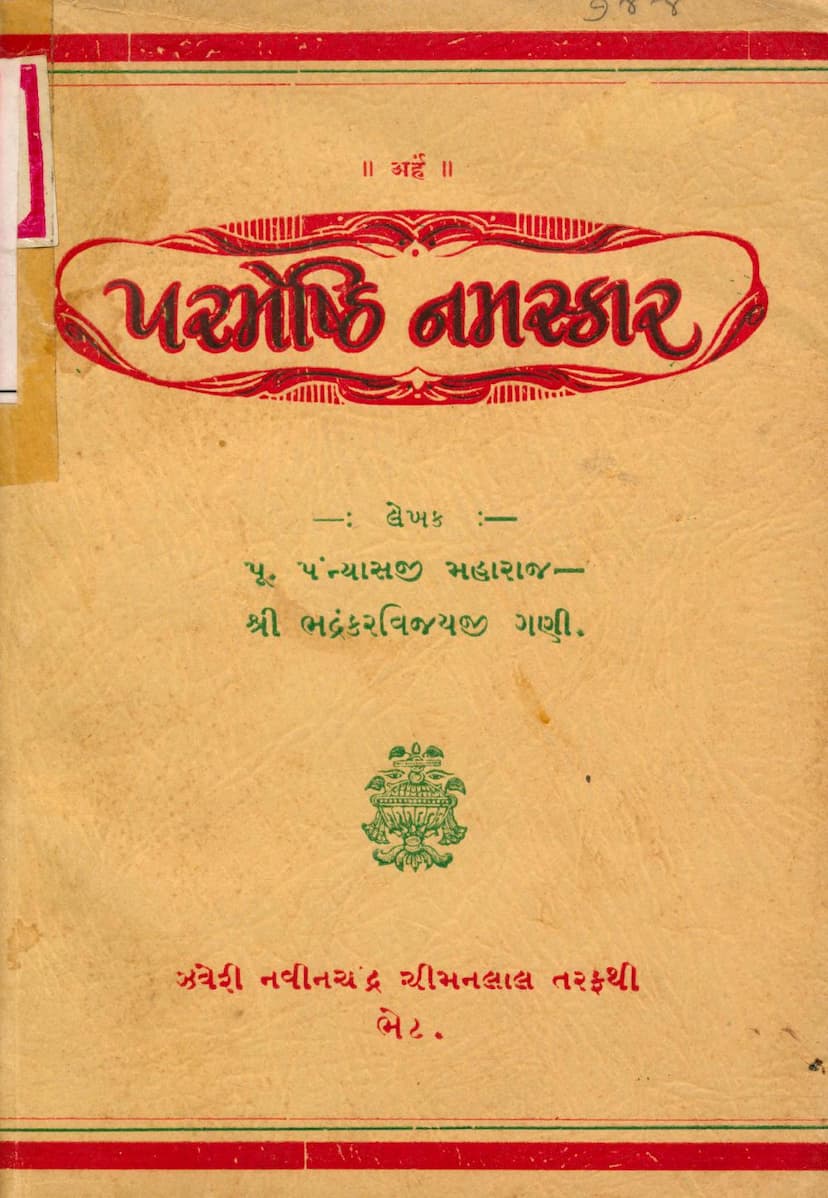Parmeshthi Namaskar
Added to library: September 2, 2025

Summary
This document is a comprehensive Jain text titled "Parmeshthi Namaskar" authored by Pu. Pannasji Maharaj Shri Bhadrankarvijayji Gani, published by Zaveri Navinchandra Chimanlal. The book is a collection of writings and thoughts on the significance and power of the Namaskar Mahamantra (also known as Navkar Mahamantra) in Jainism.
Here's a breakdown of the key aspects presented in the document:
1. Title and Author:
- Title: Parmeshthi Namaskar (also referred to as Shri Navkar Mahamantra)
- Author: Pu. Pannasji Maharaj Shri Bhadrankarvijayji Gani
2. Publisher and Donation:
- The book is published by Zaveri Navinchandra Chimanlal, and the catalog link is provided as jainqq.org/explore/022962/1.
- The publication appears to be a donation, likely in commemoration of the mother of the publishers, Sau. Shrimati Manekben, who performed various austerities.
3. Core Message and Philosophy:
- The central theme of the book is the unparalleled importance and power of the Parmeshthi Namaskar (the five supreme beings in Jainism: Arihants, Siddhas, Acharyas, Upadhyayas, and Sadhus).
- It emphasizes that the Namaskar Mahamantra is the essence of the fourteen Purvas (ancient Jain scriptures) and a supreme mantra that surpasses even divine jewels like the Kalpa Vriksha (wish-fulfilling tree) and Chintamani (wish-fulfilling gem).
- The text highlights that true understanding and realization of the Namaskar Mahamantra come through its methodical and continuous worship (Aradhana).
- It posits that reciting the Namaskar Mahamantra is not merely a ritual but a profound "Anupreksha" (contemplation) that purifies the soul, combats negative thoughts, fosters spiritual growth, and ultimately leads to liberation (Moksha).
- The book stresses that "Gunraag" (love for virtues) is the underlying principle behind Namaskar. It asserts that praising and respecting virtues in others is as essential as repenting for one's own faults. The Namaskar Mahamantra is presented as the embodiment of this Gunraag.
- It is described as the foundation of all Dharma (righteousness), the seed of spiritual progress, and the key to attaining supreme happiness and salvation.
4. Key Themes and Chapters (as indicated by the index): The index reveals a structured approach to understanding the Namaskar Mahamantra:
- Introduction and Publisher's Note: Explains the purpose and background of the book's publication.
- Introduction of the Author: Briefly mentions the author's spiritual background and efforts.
- The Universality of Shri Namaskar Mahamantra: Discusses its application and relevance across different aspects of life and knowledge.
- The Omniscience of Shri Namaskar Mahamantra: Explores its all-encompassing nature.
- The Influence of the Panch Parmesthi Namaskar: Details the power and impact of bowing to the five supreme beings.
- The Unthinkable Power of Shri Namaskar Mahamantra: Focuses on its miraculous capabilities.
- The Pervasiveness of Shri Namaskar Mahamantra: Examines its widespread presence and influence.
- Namaskar as Man's Innate Dharma: Argues that bowing to the virtuous is a natural human tendency.
- The Supreme Desirability of Shri Namaskar Mahamantra: Highlights why it is the most valuable thing to pursue.
- The Inner Wealth: Shri Navkar: Portrays the mantra as a source of true inner wealth.
- The Contemplation of Namaskar: Discusses the practice of focusing on the mantra.
- The Meditation of Shri Namaskar Mahamantra: Guides on how to meditate on the mantra.
- Types of Auspicious Meditation and the Namaskar Mahamantra: Links meditation to the mantra.
- The Auspicious Shri Navkar: Reinforces its auspicious nature.
- The Invocation and Declaration of Shri Navkar: Refers to the active calling and proclamation of the mantra's power.
- Study and Navkar: Connects scriptural study with the mantra.
- The Benefits of Namaskar Mahamantra: Dedicated to explaining the numerous benefits (in multiple parts).
- The Nine Rasas in Navkar: Explores the aesthetic emotions (rasas) associated with the mantra.
- Appendices: Include related texts, stories, verses, and commentaries on the Namaskar Mahamantra, its meaning, and its significance from various perspectives (scientific, mantra, etc.).
- Songs/Bhajans: Conclude with devotional songs praising the Namaskar Mahamantra.
5. Philosophical Underpinnings:
- The text frequently uses analogies and metaphors to explain the unfathomable greatness of the Namaskar Mahamantra, comparing it to mountains, fire, wind, clouds, sun, seeds, and even divine tusks of a boar.
- It stresses the importance of "Vidhiyukt Aradhana" (worship with proper procedure and devotion) as the true path to understanding the mantra's glory.
- The concept of "Anupreksha" (deep contemplation and reflection) is presented as crucial for internalizing the mantra's meaning and power.
- The book connects the Namaskar Mahamantra to the core Jain principles of non-violence (Ahimsa), self-control (Sanyam), and detachment (Vairagya).
- It emphasizes that the mantra is not just for the learned but accessible to everyone, regardless of age or background, due to its simplicity and clarity.
6. Practical Aspects:
- The book likely includes guidance on chanting (Japa), meditation (Dhyana), and contemplation (Anupreksha) related to the Namaskar Mahamantra.
- The appendices suggest detailed explanations of mantra rituals, protections (Vajrapanjara Stotra), and the philosophy behind chanting.
7. Cultural Context:
- The publication details (like the first edition date, Purushottamdas Patel as printer, etc.) place the book in a specific historical and cultural context, likely from mid-20th century India.
- The mention of the Zaveri family and the dedication in memory of Manekben signifies a tradition of charitable religious publications.
In essence, "Parmeshthi Namaskar" serves as a devotional and philosophical guide to the Jain Namaskar Mahamantra, aiming to deepen the reader's understanding, faith, and practice, ultimately leading them towards spiritual well-being and liberation. It presents the mantra as a divine tool for purification, protection, and the ultimate attainment of spiritual goals.